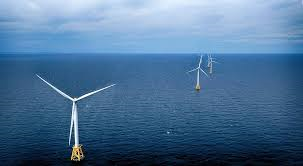By Gus Meyer
Oregon’s coast is drawing the attention of ocean wind turbine installation planning for production of clean energy by the US Bureau of Ocean Energy (BOEM).
BOEM recently held a lightly announced public information meeting kicking off Oregon Clean Energy planning in our outer Pacific Ocean shelf. Oregon principal agencies regulate Pacific waters from the beach out 3 miles to sea. BOEM regulates site licensing of the outer shelf territory from 3 miles to 200 nautical miles out in the ocean from state controlled waters.
Let’s take a look at a planned Coos Bay wind energy farm in the works. This plan encompasses 5 wind turbine towers 640 feet tall above sea water and a restrictive use site of 10 square miles. This site at full output of energy is capable of generating 40 gigawatts of clean electrical power. (EDITOR’S NOTE: A gigawatt of power will provide enough energy for about 700,000 homes.)
Taking a social/economic/environmental impact quick eye look reveals that reported by the many other worldwide wind farm installations declares close attention to details.
The reported turbines of use are 640 feet tall and will be clearly visible from shore within the 20 mile zone with their spinning red lights. Their vibrations, sound, and surface disturbance is to be an environmental impact analysis now undergoing analyses from actual worldwide installations.
Industrial technology is already building the next generation of ocean wind energy turbines designed to produce 12 gigawatts each with a resulting height of 840 feet above sea level. This is to reduce clean energy costs down over time.
Environmental impacts are undergoing for Pacific Ocean waters. About a year ago National Geographic magazine published an article on sound, vibration, and surface disturbance effects on our ocean waters. This article described affects to some ocean wildlife.
The fishing fleets are concerned as to loss of fishing grounds, the environmental impacts, any required salvage operations, and their navigational routing changes.
And it doesn’t stop with the overview above, there’s the export power to coast and subsequent new land grid distribution systems management.
Thereby it is easy to present partisanship actively as to the drivers of ocean wind energy generation. Oregon has passed legislation against fossil fuel disturbances off Oregon shores, yet encompasses wind platform social / economic enterprises.


